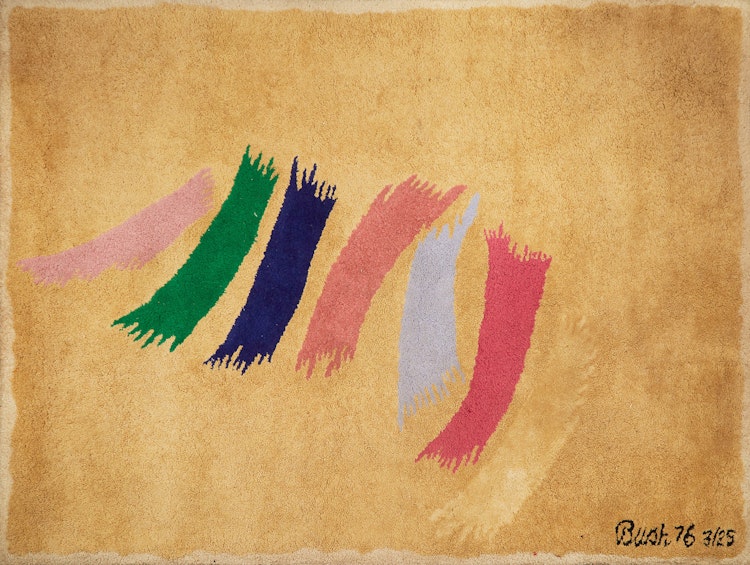Untitled Tapestry by Jack Hamilton Bush

Jack Bush
Untitled Tapestry
acrylic fibre tapestry
signed, dated 1976 and numbered 3/25 lower right
76 x 101 ins ( 193 x 256.5 cms ) ( overall )
Auction Estimate: $3,000.00 - $5,000.00
Price Realized $6,600.00
Sale date: February 1st 2022
Private Collection, Victoria, British Columbia
“Canadian Tapestries 1977: an exhibition of 23 tapestries designed by Canadian painters and sculptors”, Art Gallery of Toronto, 1977, page 5, reproduced page 19
The mastery of Jack Bush is evident in this work, in which he has played with the interaction of the ground and the shapes on top, similar to the technique displayed in his iconic canvases of this period. Beginning in late 1974, the artist was inspired by music. The lively contrast of irregular, playful ’feathery arcs’ articulated in vibrant colours that vibrate across the surface of this tapestry is akin to this musical association, and point to the establishment of a new kind of unity in his artistic oeuvre. This tapestry was based upon the painting, “Swing and Sway”, created in April 1976. Bush had the opportunity to discuss the tapestry project with Fay Loeb in 1976, however, he only saw the first proof and provided colour change instructions at the time. Bush never had the opportunity to view the completed project, as the tapestries and exhibition were produced after the artist’s death.
We sincerely thank Kim Bush of LoveJack.ca for providing her assistance with this artwork.
Share this item with your friends
Jack Hamilton Bush
(1909 - 1977) Painters Eleven, Canadian Group of Painters, OSA, ARCA
A founding member of the Painters Eleven group and the subject of major retrospectives at the Art Gallery of Ontario (1976) and the National Gallery of Canada (2014), Jack Bush (born March 20, 1909 in Toronto; died January 24, 1977 in Toronto) was one of Canada’s most influential artists. Among the first Canadian painters of his generation to achieve international success in his lifetime, Bush was a masterful draftsman and colourist whose works are coveted by major institutions and private collectors throughout the world. Born in the Beaches neighbourhood of Toronto in 1909, Bush spent his childhood in London, Ontario, and Montréal, Québec, where he studied at the Royal Canadian Academy and apprenticed as a commercial artist in his father’s business, Rapid Electro Type Company. After relocating in 1928 to work in the firm’s Toronto offices, his interest in fine art grew through contact with members of the Group of Seven, the Ontario Society of Artists, and the Canadian Group of Painters. Working as a commercial artist by day, Bush painted and took night classes at the Ontario College of Art (now the Ontario College of Art and Design University) throughout the 1930s, studying under Frederick Challener, John Alfsen, George Pepper, J. E. H. MacDonald, and Charles Comfort. After forming the commercial design firm Wookey, Bush and Winter in 1942 with partners Leslie Wookey and William Winter, Bush remained engaged in the graphic art world until his retirement in 1968.
Like many of his contemporaries in Toronto, Bush had little exposure to international trends of modernism during his formative years as a painter. For nearly two decades, he drew inspiration for his landscape and figural paintings from works by members of the Ontario Society of Artists and the Canadian Group of Painters. Though he began to incorporate non-representational elements in his work in the late 1940s, Bush’s more focused experimentations with formal abstraction in the early 1950s reveal the conspicuous influence of his eventual encounters with modern artwork in Toronto and New York City. In 1953, Bush joined the newly-founded Toronto artist group Painters Eleven. Through his involvement in the group’s efforts to promote abstract painting in Canada, Bush met the influential New York City art critic Clement Greenberg. Their resulting friendship would influence Bush’s early development as an abstract painter, with Greenberg serving as an occasional mentor to the artist, encouraging him to abandon his Abstract Expressionist style in favour of a brighter, more refined palette and technique. Through his association with Painters Eleven, Bush became closely tied to Colour Field painting and Lyrical Abstraction—two movements that had evolved from Abstract Expressionism. After the group disbanded in 1959, Bush’s distinguished career was marked by numerous achievements, including the opportunity to represent Canada at the São Paulo Art Biennial in 1967, after which his art found considerable commercial success in the United States (Bush had already been showing his work in New York City since 1962). In 1963, Hugo McPherson in his review of Bush’s showing at the Gallery Moos, Toronto, linked Bush with Matisse as follows, “...he reminds us of the classical joy and simplicity of the later Matisse. This is his richest vein. His comments on France, Italy, and Spain, and his observations titled ‘Red on Pink’ and ‘Growing Plant’ are at once spare and bright and probing.”
In 1972, Bush was the subject of the inaugural survey exhibition in the modern wing of the Boston Museum of Fine Arts. Four years later, the Art Gallery of Ontario organized a major touring retrospective of his work. Bush as a member of the Canadian Society of Painters in Water Colour, 1942 (former President); Ontario Society of Artists (former Vice-President) 1943; Associate Royal Canadian Academician, 1946; Canadian Group of Painters’, 1948, and the Art Directors’ Club of Toronto. In 2014, the National Gallery of Canada hosted a major retrospective exhibition of Jack Bush’s work. A comprehensive catalogue raisonné of Bush’s work is set to be released in the coming years.
Jack Bush died at the age of 68 in 1977, one year after he received the honour of Officer of the Order of Canada.

